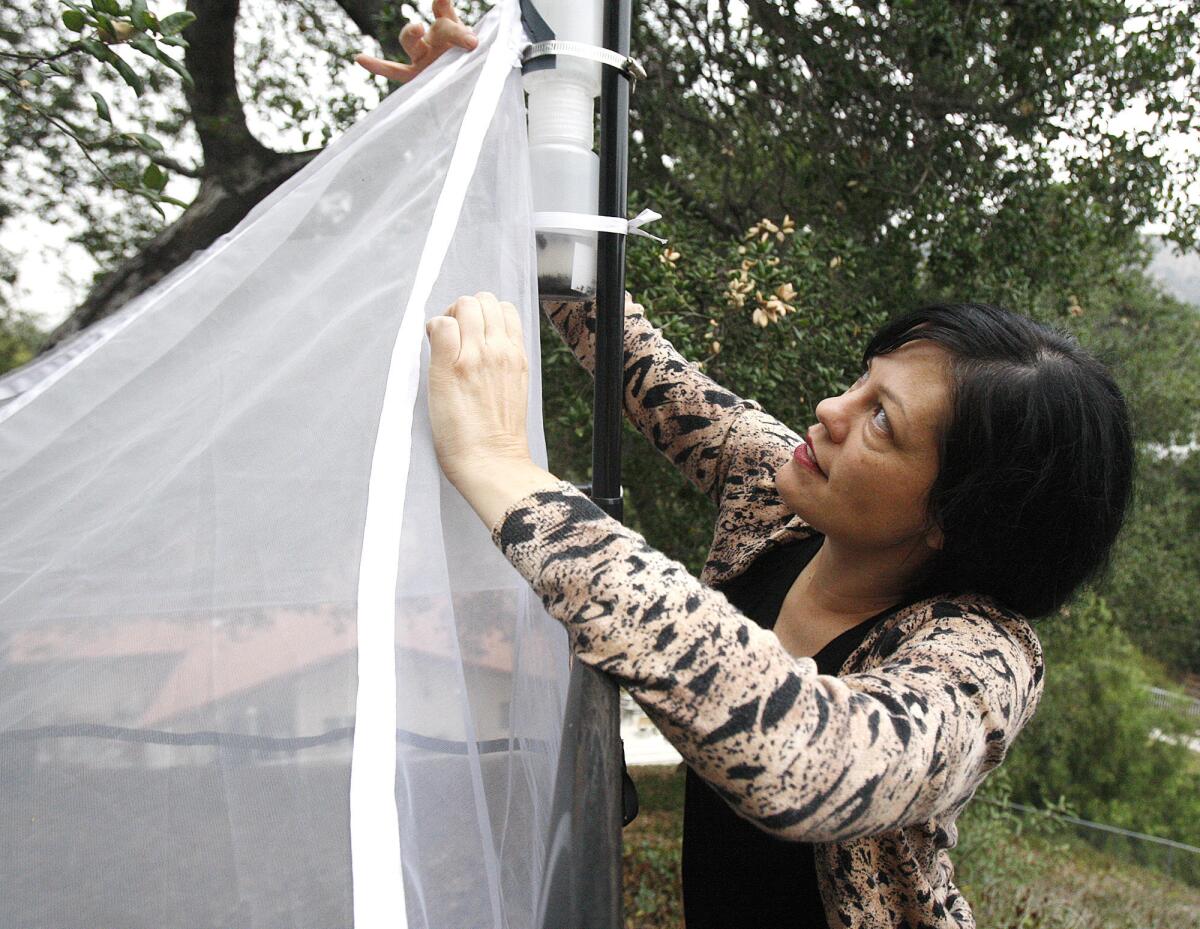Bug traps capture ant-decapitating fly, insects

Lisa Gonzalez ducked under a tent used to catch bugs in a Glendale backyard and reached her arm into a small bottle at the tip of the trap. She pulled out what looked like a clump of dirt. As the insect expert began to unravel the bundle, dozens of bug carcasses spewed into her hand as she picked through a crumpled-up spider web.
Spiders often set up camp in the 30 bug-catching tents the Natural History Museum has erected throughout Los Angeles, Glendale and Burbank for a three-year project studying insects in the urban environment.
PHOTOS: The Natural History Museum’s Bioscan Project
Those spiders that successfully spin a web without falling into a pool of ethanol used to preserve the captured insects hit the jackpot as thousands of bugs fit for their dinner are caught weekly in the traps.
Gonzalez is assistant collections manager for the museum project called “Biodiversity Science: City and Nature.” She was showing the spider web off to Celeste and Tim Armstrong and their three children this week as she retrieved several bug-filled bottles that the family had collected from the roughly 6-foot by 4-foot tent that’s been in their backyard for about four months.
“I like seeing all the different kinds of bugs, like the four moths that are in there now,” 9-year-old Lilly Armstrong said as her twin brother, Daniel, teased that she usually detests insects.
“They’re OK,” Lilly said. “As long as they’re in the bottle.”
For her mother, participating in the Los Angeles museum’s research project on insects is a way to get her children interested in science since she believes the subject is taught inadequately in schools.
On top of that, Celeste Armstrong isn’t afraid of insects — she keeps an empty wasp nest in her freezer so one day her children can bring it to school for show-and-tell — so she’s the one who replaces the bug-catching bottles attached to the tent each week.
“It takes a special person to put a bug trap in their backyard,” Gonzalez said.
In addition to the Armstrongs, another Glendale family, the Hoffmans, has erected a bug-catching tent in their backyard adjacent to the Verdugo Mountains. That one has already caught ant-decapitating flies, a special find for the researchers. The flies inject eggs into certain ants and eventually the ant’s head is severed by the developing maggot, Gonzalez said.
The Hoffmans were surprised to hear about the unexpected discovery of not one, but two species of ant-decapitating flies in their hillside yard.
“We had never heard of it before,” said James Hoffman.
The two Glendale sites may trap different bugs because of their surrounding environments. The Hoffmans live in the Scholl Canyon neighborhood, while the Armstrongs reside near the Geneva Street bridge with the Verdugo Wash below, so their tent captures numerous midges, which are small flies attracted to water sources.
The goal of the museum insect researchers is to collect samples from different areas and discover what kinds of creatures live in different parts of Los Angeles and why they live in those particular spots.
It’s not uncommon for bug-catching tents to be erected in exotic locations, but it’s unique to pitch them in local backyards, Gonzalez said. The site hosts have all agreed to manage the tents for two years.
Sometimes the tents require maintenance. Raccoons shredded one to pieces and a bird destroyed another, Gonzalez said. The Hoffmans tent recently got knocked over and tossed down a hill in their backyard by a gust of wind.
Gonzalez carries around an orange toolbox filled with wrenches, twist ties, PVC glue and other items she may need to repair a tent when she’s collecting bottles of insects. In addition to picking up the bugs preserved in bottles of ethanol, she also takes readings from weather stations set up near the tents.
Museum researchers plan to study the impacts of weather, soil temperature, leaf moisture and other factors on bug attraction. When Gonzalez takes the insects back to the museum, a team of 20 college students clean the roughly 5- to 6-millimeter-long creatures using a mesh-like substance and group them into categories for researchers to examine. About three-quarters of the captured specimens are flying insects.
Gonzalez knows that everyone loves bugs as much as she does. In fact, she used to capture insects and play with them in her dollhouse when she was a young girl.
“I think bugs can be gross, too. I just want people to know that most insects are harmless and there’s a fine line between being freaked out and being fascinated by bugs,” Gonzalez said. “If people spend a little time being curious, maybe they can turn that fear into fascination.”
--
Follow Brittany Levine on Google+ and on Twitter: @brittanylevine.
ALSO:
Area students to test science knowledge
Verdugo Views: Distinguished alum has Armenian heritage
Glendale continues to invest in capital improvement projects